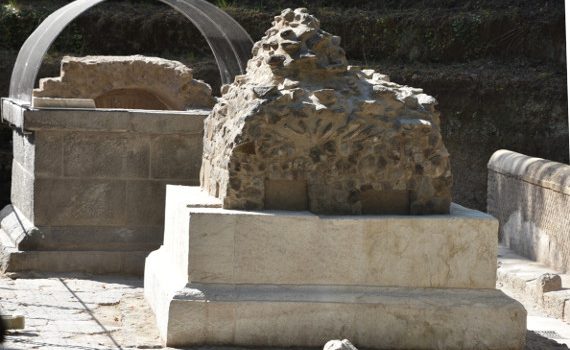The tombs of the necropolis of Porta Stabia
New archaeological investigations redefine the urban spaces of this area of the ancient city
Recent archaeological investigations at the Port Stabia necropolis have provided new and useful elements for understanding the complex spatial arrangement of this section of Pompeii, which will soon be opened to public access. Along Via Stabiana, just outside the ancient city gate of the same name, restoration and development operations on two funeral monuments began in the fall of 2017, in an area adjacent to the monumental tomb of Gnaeus Alleius Nigidius which was brought to light last year. These are two chamber tombs christened ‘Tomb A’ and ‘Tomb B’, excavated in 2001 and located in an area bound by a pavement and a small plaster coated opus reticulatum wall.
The excavations sought to unearth and document the road network. The road paving was indeed entirely covered in a thick layer of alluvial deposits, which has yielded a large quantity of ceramic and glass finds, such as lacrimatories and board game pieces, but also a golden ring with facing serpent heads and cast glass eyes. The removal of this deposit layer revealed an unfinished sub-square masonry structure to the south of Tomb A. These pieces of evidence likely relate to a third tomb, which was unfinished following the abandonment of the site, as the tuff and lava blocks which were discovered in the immediate vicinity and appeared ready to used in construction would indicate, along with a pile of lava and small block chips.
Tomb B, which is rectangular in shape, is formed of two rows of white limestone parallelepiped blocks; the tomb was probably crowned with an altar shaped element. On three sides the plastered interior has rectangular niches, while the fourth includes the access to the chamber. At the time of the restoration work inside the burial chamber - which was in a poor state of conservation - it was revealed that only four of the nine clay urns fixed into the two raised areas along the sides of the chamber had previously been emptied, probably during the nineteenth century explorations, which brought about the destruction of the limestone coating of the upper part of the tomb and the removal of the glass urns in the niches. Of the 5 urns which had not been previously emptied, two revealed the ashes of the deceased, while another two contained the remains of the ustrinum (funeral pyre), such as glass unguentaria deformed by the heat, and in one case a coin placed as a Charon’s obol. The anthropological remains are currently being studied by H. Duday. Some urns retain their lids in the closed position, but inverted. A clay conduit was discovered on the cocciopesto floor, for the libations in honour of the deceased which took place during the various festivities; the conduit was closed by a marble element.
Tomba A is an almost square shaped structure formed of an elevated foundation of grey tuff parallelepiped blocks, joined together by metallic clamps (at least on the northern side), onto which the roofing was built, consisting of a series of small steps of earth, lava stones, limestone chips and mortar, of which at least the lowest was conserved in situ. Within the burial chamber, there are niches in three sides of the brick wall. At the time of the 2001 excavation, two glass cinerary urns with lids were found; the tomb also contained two blown glass doves and a small jug. The entrance to the tomb is located on the southern side, and is closed by a limestone door, which features two legible tituli picti. The door has an iron ring on the outside, and a bronze locking system on the inside, as well as bronze hinges. The door was closed at the time of the excavation, and was opened for the restoration works, revealing that it still worked perfectly, 2000 years since the Roman locking mechanism was crafted. On the upper part of the door an inscription is present, in the form of a titulus pictus, which reports “Iarinus Expectato / ambaliter unique sal(utem) / Habito sal(utem)” “Iarinus greets Expectatus as an eternal friend; greetings to Habitus”. Above the name of Habitus, somebody drew a phallus.
Download Pictures


